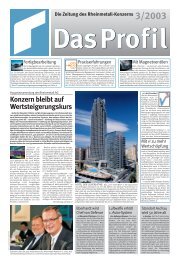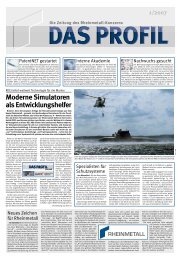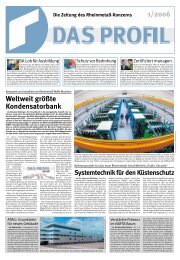PDF [1.6 MB] - Kolbenschmidt Pierburg AG
PDF [1.6 MB] - Kolbenschmidt Pierburg AG
PDF [1.6 MB] - Kolbenschmidt Pierburg AG
You also want an ePaper? Increase the reach of your titles
YUMPU automatically turns print PDFs into web optimized ePapers that Google loves.
Newsline<br />
Fire Control Unit FCU 40mm HV from Rheinmetall Defence in operation (left): the distance is measured by means of the laser<br />
range-finder, other sensors measure the relevant influence factors like air pressure, temperature, target line angle and canting.<br />
These values and the known ballistics are used to compute and automatically set the angle of elevation. The gunner therefore always<br />
has the target at the center of the angle of view. Night mission: The new fire control unit is also available as a smaller and<br />
lighter unit (as a fire control visor) – and is particularly well suited for hand-held weapons and shoulder-fired anti-tank weapons.<br />
Fire control technology from Rheinmetall Propellants unit<br />
Enhancing the efficiency of ABM<br />
Stockach. Advanced ammunition concepts<br />
– like the new 40mm air burst ammunition<br />
(ABM) for the grenade launcher<br />
of RWM Schweiz <strong>AG</strong> – need equally<br />
advanced technologies to fire the ammunition<br />
as efficiently as possible. Situated<br />
near Lake Constance in South Germany,<br />
Stockach-based Oerlikon Contraves<br />
GmbH (OCD) has set new standards<br />
in fire control technology, ideally<br />
complementing ABM systems to further<br />
enhance the efficiency of ammunition<br />
concepts. This has been rendered possible<br />
by modern fire control systems of<br />
the type FCU 40mm HV (High Velocity),<br />
allowing the projectile to be programmed<br />
with innovative technologies<br />
and hence permitting the optimized deployment<br />
of high-tech ammunition.<br />
Gerhard Wieland, head of mechanical<br />
and electrical design and responsible<br />
for fire control units at Oerlikon Contraves<br />
GmbH: “Fire control is an essential<br />
prerequisite to program ABM ammunition.<br />
The destruction of the projectile<br />
at a defined distance means that<br />
targets located inside or behind protective<br />
covers can be engaged, e.g. in<br />
trenches or behind walls.”<br />
According to 50 year-old Wieland<br />
from Höri, a peninsula at the western<br />
end of Lake Constance, this is one of<br />
the main advantages of the combination<br />
of modern ABM ammunition with<br />
advanced fire control systems. Furthermore,<br />
the fire control unit FCU 40mm<br />
HV offers superior hit accuracies in<br />
daylight and higher hit rates at night.<br />
Distances are measured by laser<br />
range-finding, sensors measure the<br />
other relevant influence factors – air<br />
pressure, temperature, target line angle<br />
and canting. Commenting on the<br />
basic concept, Wieland points out:<br />
“These values and the known ballistics<br />
are used to compute and automatically<br />
set the angle of elevation. The gunner<br />
therefore always has the target at the<br />
center of the angle of view.” The other<br />
sensors like the laser or terrain angle<br />
sensor are likewise orientated precisely<br />
to the target. “This allows a direct<br />
target change from one target to the<br />
next and quick engagement. Most competing<br />
products have to be restored to<br />
the neutral position when a new target<br />
is chosen.”<br />
The flight time calculated by the fire<br />
control system is inductively sent to the<br />
projectile via a coil – contrary to conventional<br />
products where the values<br />
are radio-transmitted after the projectile<br />
has left the barrel. Says Wieland:<br />
“Our fire control units don’t need a radio<br />
link which is easily jammed.”<br />
OPI award for<br />
two years running<br />
Hiroshima/Neckarsulm. For the<br />
first time ever, the Japanese facility<br />
KS <strong>Kolbenschmidt</strong> K.K. has succeeded<br />
in winning the OPI award for two<br />
years running — in 2005 and 2006.<br />
In fact, this represents an outstanding<br />
achievement since the location<br />
has once again managed to top its<br />
excellent year-earlier performances.<br />
It was only in 2003 that KS <strong>Kolbenschmidt</strong><br />
took over from Mazda Motor<br />
Corporation the piston production of<br />
10<br />
Influence factors which should not be<br />
underrated are the air pressure and air<br />
temperature as they change the air<br />
density and also aerodynamic drag. An<br />
exact measurement of the target parameters<br />
is therefore crucial. The laser<br />
range-finder measures the target range<br />
with an accuracy of ± 2 meters. Wieland<br />
explains why this accuracy is so important:<br />
“At a target range of 1000 meters,<br />
an air pressure reduction of only 100<br />
hPa – corresponding to a terrain elevation<br />
of 1000 meters – increases the firing<br />
distance by 15 meters; a temperature<br />
increase of 25 degrees causes a<br />
similar deviation.” This means that<br />
OCD’s modern fire control systems<br />
which are capable of exactly determining<br />
and using the target parameters are<br />
extremely well suited for use in conjunction<br />
with ABM ammunition, and<br />
are – in this combination – therefore<br />
particularly appropriate for existing<br />
tactical scenarios.<br />
Microtechno Corporation, Hiroshima,<br />
Japan. The acquiree had since 1972<br />
been manufacturing pistons and other<br />
precision parts for the automotive<br />
and further sectors of industry.<br />
At the time of takeover, sales<br />
added up to around € 20 million and<br />
the workforce totaled 120. Today,<br />
around 220 employees generate<br />
sales just short of € 38 million<br />
(2006) with the production of pistons<br />
for auto engines, light- and<br />
medium-duty commercial vehicle engines<br />
as well as assemblies and<br />
built-in engines for Hino Motors,<br />
Subaru, Mazda, Shibaura, and Iseki.


![PDF [1.6 MB] - Kolbenschmidt Pierburg AG](https://img.yumpu.com/8657804/10/500x640/pdf-16-mb-kolbenschmidt-pierburg-ag.jpg)
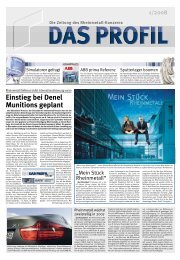



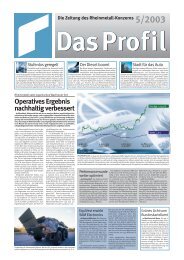
![PDF [2.4 MB] - Kolbenschmidt Pierburg AG](https://img.yumpu.com/8295864/1/184x260/pdf-24-mb-kolbenschmidt-pierburg-ag.jpg?quality=85)
![PDF [2.5 MB] - Kolbenschmidt Pierburg AG](https://img.yumpu.com/8112793/1/184x260/pdf-25-mb-kolbenschmidt-pierburg-ag.jpg?quality=85)




